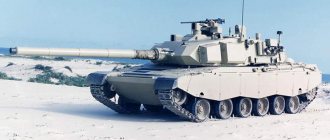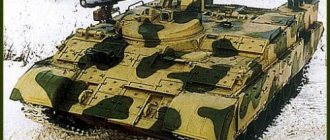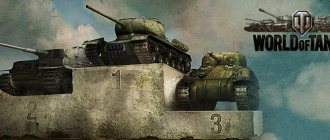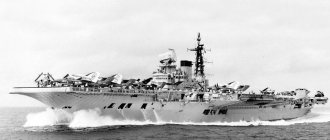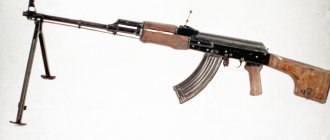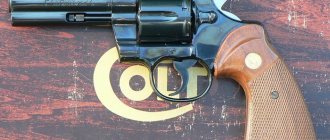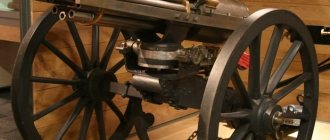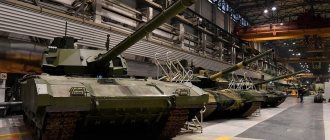Performance characteristics (TTX)
general information
- Classification - main battle tank;
- Combat weight - 41 tons;
- The layout is classic;
- Crew – 3 people;
- Years of development: from 1967 to 1973;
- Years of operation: since 1974;
- The number produced is about 30 thousand pieces.
Dimensions
- Case length – 6670 mm;
- Length with gun forward – 9530 mm;
- Hull width - 3590 mm (along side screens) / 3370 mm (along tracks);
- Height – 2190 mm;
- Base - 4270 mm;
- Ground clearance - 428-470 mm.
Booking
- Type of armor - rolled and cast steel and steel-textile-steel combined;
- Body forehead - from 310 (450) to 750 (1100) mm in various modifications;
- Body forehead (top) - total 205 / 68° mm/deg and second layer 60°, combined;
- Body forehead (bottom) - 85/60° mm/deg;
- Turret forehead - from 410(500) to 800(1200) mm in various modifications.
Armament
- Caliber and brand of gun - 125 mm 2A26;
- Gun type: smoothbore gun;
- Barrel length - 48 calibers;
- Gun ammunition - 39;
- BH angles: -6°13'…+13°47';
- GN angles – 360 degrees;
- Firing range - up to 9.4 km;
- Sights - rangefinder sight TPD-2-49, periscope night sight TPN-1-49-23;
- Machine guns - 1 × 12.7 NSVT, 1 × 7.62 mm PKT.
Mobility
- Engine type and brand – V-46 V-shaped diesel 12-cylinder with liquid cooling;
- Engine power – 780 hp;
- Highway speed – 60 km/h;
- Speed over rough terrain – 35-45 km/h;
- Cruising range on the highway – 500-650 km;
- Cruising range over rough terrain – 320-650 km;
- Suspension type: individual torsion bar;
- Specific ground pressure - 0.83 kg/cm²;
- Climbability – 30 degrees;
- The wall to be overcome is 0.85 m;
- The ditch to be overcome is 2.6-2.8 m;
- Fordability - 1.2 m.
Tank T 72 photo
Main battle tank T 72 photo The most popular and famous second generation tank in the world. It is in service with Russia and 30 other countries around the world. Created on the basis of the T-64A tank . It was developed at the Uralvagonzavod design bureau from 1967 to 1972 as “object 172”, after modernization as “object 172M”. Factory tests since November. In 1972, an initial batch of 15 vehicles, together with T-64A and T-80 tanks, underwent many months of military tests. Based on their results, it was recommended for adoption under the designation T-72 “Ural”.
T-72 tank photos of all modifications about 30 thousand were produced over 25 years
The tank was mass-produced at UVZ from 1974 to 1992, and from 1978 to 1990 at ChTZ. The total number of T-72s produced is estimated at 20,000-25,000. The car was also produced in Czechoslovakia, Poland, Yugoslavia, India, Iran and without a license in China.
The T-72 in the photo had nuclear, biological and chemical protection systems
The tank has a classic layout.
t 72 characteristics
The crew consists of three people.
The automatic loader replaced one of the crew members, the rate of fire was 8 rounds per minute
The T-72 hull is a box-shaped structure made of sheets and plates of rolled homogeneous and combined armor. Main tank T-72A photo . Early 1980s
T-72 on parade in East Berlin 1984
The combined hull armor consists of 80 mm steel outer, 105 mm fiberglass and 20 mm steel inner layers. For the T-72A tank it was changed to layers 60+100+50 mm thick and reinforced by welding a 30 mm armor plate. The T-72B's frontal hull armor has been further enhanced by adding 20mm armor plate. Later, the T-72B hull received the Kontakt mounted dynamic protection, then the Relikt.
photo tank T-72, 41.5 tons of steel and composite armor
The engine and transmission compartment is separated from the combat compartment by an armored partition. But the ammunition is still in combat condition, the Achilles heel of all Soviet, and now Russian-built tanks. The combat weight of the T-72A tank is 41.5 tons.
T-72 is relatively short, there is little space inside the tank, as a result a very low profile, 125mm D-81TM, smoothbore gun, a pipe above the turret allows you to ford rivers
The towers of the first series were cast and had a complex design. In 1979, the T-72A tank with combined turret armor was put into service. Its front part had a thickness of 280 mm.
view of the commander's seat of the T-72AG tank
In the control compartment, to the right of the driver’s seat, there is a fuel tank and a storage tank, on the left is a fuel tank, control panel and batteries.
torsion bar suspension provides the car with excellent ride comfort t 72
There is an inspection hatch above his seat, and an emergency exit hatch in the bottom of the hull, behind the seat. The TNPO-168V operator-driver observation device is mounted in the upper inclined sheet of the housing. The turret of the tank T 72 photo contains a 125 mm D-81TM smoothbore gun. The tank's ammunition load includes 44 separate-loading rounds with armor-piercing sub-calibre, cumulative and high-explosive fragmentation shells. The tank uses an electromechanical automatic loader. 22 artillery rounds from the ammunition load are placed in cassettes of a rotating ammunition rack.
T-72 tank lower front plate, self-entrenchment equipment (which when folded is additional armor protection)
To aim the gun at the target, a daytime sterioscopic sight-rangefinder is installed. The T-72 commander's cupola contains two TNP-160 observation devices, a TKN-3 commander's observation device and a night sight. The Luna illuminator is used as a source of infrared light. With a cannon there is a 7.62-mm PKT machine gun. On an open turret installation, an NSVT-12.7 “Utes” machine gun with a collimator sight and manual aiming is used as an anti-aircraft gun. Smoke grenade launchers are located on the tower. Their number depends on the modification of the machine.
the number of smoke grenade launchers depends on the modification of the T 72 vehicle
The tank is equipped with a 12-cylinder multi-fuel diesel engine V-46 with a transmission and a centrifugal supercharger with a power of 780 hp. Since 1984, the T-72A has had a V-84 diesel engine with a power of 840 hp. The engine is installed in the engine compartment across the axis of the tank.
Bram 1 was created on the basis of the chassis of the main tank T-72 photo, adopted for service in 1975
The roller suspension is independent torsion bar with hydraulic shock absorbers. The chassis consists of six rubber-coated support rollers, three support rollers on board, guide and drive wheels with removable rims.
T-72 tank poor protection of the side projection of this tank, the sides are protected by rubber screens, perhaps from flying dirt, but not from enemy shells
Caterpillars with rubber-metal joints. The track rollers are made of aluminum alloy, the rest are made of steel. Vehicle speed on the highway is up to 60 km/h. Power reserve 500 km.
| Parameter | T-72B | T-72 modernized |
| Combat weight, t | 44,5 | no more than 46 |
| Cannon, stamp | 2A46M | 2A46M-5 |
| Caliber, mm | 125 | 125 |
| Anti-aircraft machine gun installation | open type | closed type with remote control |
| Modular remote sensing | "Contact-V" | "Relic" |
| Automated curtain installation system | No | There is |
| Electromagnetic Protection System | No | There is |
| Day sight | Sighting system 1A40-1 | Multi-channel gunner's sight "Sosna-U" with sighting and TPV channels, laser range finder and laser missile control channel |
| Night sight | PPN 1K13-49 electro-optical monocular periscope | |
| Detection and recognition range of a tank-type target at night, m | 1300 | not less than 3300 |
| Duplicate weapons control mode from the commander's seat | No | There is |
| Double sight | No | sight-rangefinder TPD-K1 |
| Ballistic computer | No | electronic digital with a set of sensors |
| Automatic target tracking | No | electronic digital with video image processing from the TPV channel of the Sosna-U sight |
| Rocket control information channel | included in PPN 1K13-49 | part of the Sosna-U multi-channel gunner's sight |
| Maximum firing range of a guided missile, m | up to 4000 (daytime, from a standstill) | up to 5000 (day and night, from the spot and on the move) |
| Radio station, brand | R-173 | R-168-25UE-2 |
| Availability of pre-prepared frequencies | 4 | 64 |
| Technical Masking Mode | No | There is |
| Frequency frequency mode (software adjustment of operating frequency) | No | There is |
| Speed of transmission and reception of digital information, bit/s | no digital communication channel | up to 16000 |
| Navigation equipment, type | No | combined (GPS and odometric) |
| Intercom and switching equipment, brand | R-174 | R-168 AVSK-B |
| Verbal intelligibility, % | 90 | 94 |
| Maximum number of subscribers connected to the intercom network | 6 | 10 |
| Engine, make | B-84-1 | V-92S2 |
| Power, hp | 840 | 1000 |
| Specific power, hp/t | 18,9 | not less than 21.8 |
| Maximum speed on the highway, km/h | 60 | 65 |
T-72С, in order to maintain superiority on the battlefield, a more advanced model was created; it retains all the positive features of the base tank, despite the presence of dynamic protection, the side projection is still vulnerable
The tank was equipped with an R-123M radio station, an intercom, an anti-nuclear protection system, an automatic fire extinguishing system, underwater driving equipment, and a device for self-entrenchment.
T-72M1M export modernization of the T-72M1 tank
It is possible to install rutted knife mine trawls on parts of the tanks.
T-72S is the world's first missile and gun tank, supplied to the market, superior to the T-72M1 tank in firepower, mobility protection, differs from its ancestors by installing fundamentally new components
"Seventy-second" was produced in a large number of modifications. To this day, its production has been completed.
During operation and combat use, the extreme explosiveness of the T-72 was revealed, it seems that this is becoming the hallmark of the entire series, the T-90 was created on the basis of the same seventy-second, has the same problems with the ammunition rack, is located in the fighting compartment
As of 2010, there were 2 thousand T-72 vehicles in operation in Russia and 7 thousand in reserve. Despite the modernization, the tank has several fundamental vulnerabilities. Weak side projection protection , the ammunition rack is combined with the crew's fighting compartment (detonation leads to the complete destruction of the tank, along with the crew), low starting speed , acceleration 0-32 km/h in 12 seconds, French Leclerc less than 6 seconds, Abrams 7.2 seconds , and the Israeli Merkava Mk.3 in 10 seconds.
The Syrians are strengthening the protection of the sides of the T-72 tank by installing grilles
The militia from Donetsk and Lugansk also strengthens the protection of the sides of their tanks with bars. The improvised mounted protection of the T-72 tank is still as ineffective against a cumulative charge as during the Second World War
T-72B3 tank after being fired at by old RPGs near Illovaisk, the torn off turret seems to be becoming a hallmark of tank building
The modernized T-72B "White Eagle" tank from Oboronservis OJSC, the same design flaws, poor protection of the side projection, the sides are protected by rubber screens and dynamic protection modules up to the middle of the tank's side, the division of ammunition cannot be solved by modernization
T 72 moment of shot photo
Such a large production, most of them are still in operation, serve as objects for infusion into the modernization of the tank. This is done both by our enterprises and by Belarusian, Ukrainian, and various concerns from France, the USA, Canada and, of course, China.
Modifications of T-72
The T-72 was produced in many modifications, not only in the USSR, but also in other countries. Only a few of them are worth mentioning separately.
Soviet modifications
The USSR created a number of experimental modifications of this tank, mainly with other guns and various additional equipment. Most of them remained experimental tanks and were not accepted into service. However, there were several serial modifications:
- T-72K – command version with additional navigation equipment, radio station and autonomous power supply;
- T-72A - major modernization after 1979 with a laser sight and other technological innovations;
- T-72AK – command T-72A;
- T-72M – export version of the T-72A with an armored turret, a collective defense system and a special configuration of ammunition;
- T-72B - modernized T-72A with a guided weapon system, Kontakt dynamic protection, V-84 engine;
- T-72BA - a variant of the T-72B with several major modifications, the result of a major overhaul of several T-72s;
- T-72B2 "Slingshot" - a more accurate tank with power protection and multiple cameras for additional targeting accuracy.
- T-72B3 - modernization of the tank, aimed at increasing its combat qualities and bringing it closer to the level of the T-90

